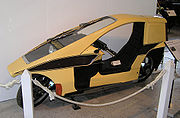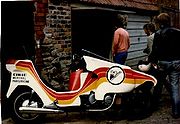
Feet forwards motorcycle
Encyclopedia

Motorcycle
A motorcycle is a single-track, two-wheeled motor vehicle. Motorcycles vary considerably depending on the task for which they are designed, such as long distance travel, navigating congested urban traffic, cruising, sport and racing, or off-road conditions.Motorcycles are one of the most...
design that seeks to look at the two-wheeled concept afresh, and create a new form of practical personal transport. The name "feet first" (also referred to as "feet forward") was first used by Royce Creasey and refers to the rider's seating position, with feet ahead in a position (like a car), rather than below and astride, as with conventional bikes. As there are other types of motorcycle
Motorcycle
A motorcycle is a single-track, two-wheeled motor vehicle. Motorcycles vary considerably depending on the task for which they are designed, such as long distance travel, navigating congested urban traffic, cruising, sport and racing, or off-road conditions.Motorcycles are one of the most...
(e.g. choppers
Chopper (motorcycle)
A chopper is a type of motorcycle that was either modified from an original motorcycle design or built from scratch to have a hand-crafted appearance. The main features of a chopper that make it stand out are its longer frame design accompanied by a stretch front end...
) that have a 'feet forward' position, an alternative term sometimes used is Advanced Single Track Vehicle.
To be classed as an FF the originators of the 'modern' FF - Malcolm Newell and Royce Creasey - came up with the definition that:
- an FF would have a seat base less than 20 in (500 mm) from the ground, at normal ride height
In practice this is not strictly adhered to, and this has developed into:
- an FF two-wheeler is defined as a single track vehicle where the rider(s) sit in tandem in much the same attitude and at much the same height as car passengers. The seat provided is similar, and sometimes identical, to a car seat
and that:
- a feet first two-wheeler has a low-mounted seat and seat back like a car
The Feet Forward motorcycle differs significantly from the conventional scooter (e.g. the Piaggio Vespa), and the maxi scooter (e.g. the Suzuki Burgman
Suzuki Burgman
The Burgman series of scooters is produced by Suzuki with engine capacities from 125 cc up to 638 cc. Models include:-AN series:...
), in that the expectation of the design is that it should out match a conventional motorcycle in terms of handling and performance, as well as in rider comfort.
History
Designers have experimented with the feet forward riding position since the early days of motorcycling.In 1909 P.G Tacchi designed a four cylinder machine with a 700cc 'L' head air cooled engine, an enclosed shaft drive and a bucket seat. The machine was known as a TAC-Wilkinson
Wilkinson TMC
The Wilkinson TMC iss a British luxury touring motorcycle manufactured by the Wilkinson Sword company in Acton, London between 1911 and 1916, when production was stopped by the first World War.-Development:...
, and was manufactured by the Wilkinson Sword Company
Wilkinson Sword
Wilkinson Sword is a brand name for companies that make gardening tools and razors. Wilkinson Sword's origins are in the manufacture of swords. The company was founded in London in 1772. The brand is currently owned by Energizer Holdings. Past product lines have included guns, bayonets, and other...
Ten years later in America Carl A. Neracher designed the Ner-a-Car It had a feet-forward riding position, a pressed steel frame and hub centre steering but in other respects was somewhat similar to a conventional motorcycle.
Designed by Sir Alliot Verdon Roe
Alliott Verdon Roe
Sir Edwin Alliott Verdon Roe OBE, FRAeS was a pioneer English pilot and aircraft manufacturer, and founder in 1910 of the Avro company...
in 1926, the Ro-Monocar used a 250cc Villiers two stroke engine, and featured a high degree of enclosure for the rider and a bucket seat. This seating position provided a high degree of comfort for the rider
The Fred Wood designed Whitwood monocar used OEC
OEC
OEC may refer to:* Offshore Energy Center, sponsor of the Ocean Star Offshore Drilling Rig & Museum in Galveston, Texas, United States* Old Earth creationism, a term for several types of creationism...
duplex steering, retractable outriggers, and tandem bucket seats, and was offered with engine sizes ranging from 250-996cc between 1933 and 1935.
In the 1950s NSU produced a feet forward fully enclosed monocoque construction "Flying Hammock" record breaker. The feet forward riding position allowed an exceptionally small frontal area. The consequent low wind resistance made it possible for H.P. "Happy" Mueller to achieve 150 mph (67 m/s) from a 150cc engine at the Utah Salt flats in 1956.
The first recognisably modern design was the 1975 Quasar
Quasar (motorcycle)
The Quasar was a semi-enclosed feet forward motorcycle, created by Malcolm Newell and Ken Leaman,who made a number of similar vehicles.It used an 850 cc engine built by Reliant Motors and was capable of cruising at 90–100 mph and exceeding 100 mph in favourable...
, built by Malcolm Newell and Ken Leaman. The design was not a great commercial success - just 22 examples were sold up until 1982 - but it generated a great deal of interest, and started others thinking about the FF concept.
Since 1984 Swiss manufacturer "Peraves" is producing small series of feet forward cabin motorcycles, the Ecomobile from 1984 to 2005, then followed by Monotracer and eTracer.
In 1989 the Royce Creasey designed Voyager achieved a pre-production run of five prototypes made by SCL Ltd in Powys South Wales
In 2002, Dan Gurney
Dan Gurney
Daniel Sexton Gurney is an American racing driver, race car constructor, and team owner.The son of a Metropolitan Opera star, he was born in Port Jefferson, New York, but moved to California as a teenager...
's All American Racers produced a limited run of Alligator
Alligator (motorcycle)
The Alligator is a Feet forwards motorcycle built by Dan Gurney Alligator Motorcycle Company which is the motorcycle division of the former driver/racing team owner's All American Racers workshop in Santa Ana, California...
models.
In 2006, the first Acabion
Acabion
Acabion is the designer and manufacturer of Acabion Road Streamliners. The Headquarter of Acabion is in Lucerne, Switzerland. Its primary official is the Lucerne based engineer Dr.-Ing. Peter Maskus.- External links :* * *...
prototype was presented at the Geneva Motor Show, a feet first cabin motorcycle.
In 2008, the Buddfab Streamliner set the speed record for a 50cc engine at 145 mph (233 km/h) with 20+ hp, then in 2009 the 125cc speed record at 186 mph (299 km/h). The Honda RS125 engine used produces 44 ps.
In 2010, Dutchman Allert Jacobs, creator of the Quest velomobile
Velomobile
A velomobile or bicycle car is a human-powered vehicle, enclosed for aerodynamic advantage and protection from weather and collisions. They are virtually always single-passenger vehicles. They are derived from recumbent bicycles and tricycles, with the addition of a full fairing . There are few...
, streamlined a Honda Innova underbone motorcycle to more than double the fuel economy
Fuel economy
Fuel economy may refer to:*Fuel economy in automobiles, refers to the fuel efficiency relationship between distance traveled by an automobile and the amount of fuel consumed*Fuel efficiency in general...
from 1 liter per 48 km (113 mpg) to 1 per 101 (237mpg).
Rationale
Modern motorcycles are simply well-developed motorized bicycleBicycle
A bicycle, also known as a bike, pushbike or cycle, is a human-powered, pedal-driven, single-track vehicle, having two wheels attached to a frame, one behind the other. A person who rides a bicycle is called a cyclist, or bicyclist....
s, and as such have drawbacks. Chief among these are:
- Safety - riders involved in an accident are at significantly higher risk of injury or death compared with car drivers.
- Weather - motorcycles do not offer the advantages of an enclosed car in poor weather.
- Convenience - conventional motorcycle riders need to wear a helmetMotorcycle helmetA motorcycle helmet is a type of protective headgear used by motorcycle riders. The primary goal of a motorcycle helmet is motorcycle safety - to protect the rider's head during impact, thus preventing or reducing head injury or saving the rider's life...
and protective clothing. - Efficiency - motorcycles have a relatively tall profile that reduces aerodynamic performance.
- Skill - motorcycles riders need training and practice to become skilled at riding.
Likewise, in dense urban environments, the car
Automobile
An automobile, autocar, motor car or car is a wheeled motor vehicle used for transporting passengers, which also carries its own engine or motor...
has a number of drawbacks:
- Road occupancy - a car takes up much more space than a single person, and most cars transport only one person. Similarly the area occupied when parked consumes considerable space.
- Environment - a car uses more fuel than a motorcycle for the same journey. It is also more expensive in terms of resources to build in the first place.
- Journey times - a car is generally a lot slower than a motorcycle for city journeys due to congestion.
The FF motorcycle is an attempt to marry the advantages of bikes and cars, while avoiding the drawbacks of either. However any FF STV has no roll stability so actual benefits are overstated by some proponents when comparing a FF motorcycle with a motorcar. In addressing these issues, most FF designs arrive at a low-slung faired body, with the rider in a reclining position.
 |
 |
 |
A number of FF concepts have been tried, but so far a commercially successful design has not appeared. There has been a revival of interest in the motor scooter as a means of personal transportation, and in some respects these vehicles have some features in common with FF motorcycles.
Problems faced
The problems faced by the designer or marketer of an FF motorcycle are many. While to some the advantages of such a design are self-evident, there are a number of problems to be overcome. Some of these are perceptual - existing motorcyclists tend to be resistant to the idea, arguing that it's not a "proper" bike, and there is nothing wrong with the standard form of motorcycle. To car drivers, many of the disadvantages of the car are either not recognised or simply put up with and the overall convenience is hard to give up. Many car drivers would not consider a conventional motorcycle or scooter as an alternative, seeing it as a far less convenient and less safe option. To these people, an FF motorcycle needs to be seen (and hence marketed) as a two-wheeled car rather than an enclosed motorcycle. As the FF design moves the rider from an upright or Head First (HF) posture to a recumbent position (as in the Quasar and Dan Gurney's Alligator), the machine becomes lower and may make it harder to see in traffic. However, most FFs have seat which are no lower than the average car, and much higher than many sports cars. Those who ride them regularly say that the problems of having a seat at this height are largely in the minds of those who have never tried one.There are some engineering issues too, though experimental designs so far built show that these can be overcome. Chief among these is the problem of stability when stationary. Designs such as the Quasar require the rider/driver to use one foot to stabilise the machine when stationary, by putting his foot out of the open side onto the road. This approach precludes the use of a fully enclosed body. The fully enclosed Peraves Ecomobiles and MonoTracers use rider-deployed stabiliser wheels, which are operated when the machine is travelling very slowly, or even just as it becomes stationary.

